Hydrangea paniculata Diamantino - rules for growing on the site
The Diamantino panicle hydrangea is native to Japan. This plant is considered an old perennial, which began to be cultivated in France in the 19th century. Later it spread throughout Europe and in Russia. Consider what a shrub looks like, what kind of care it needs and growing conditions.
- Description of the plant
- Landing features
- Timing
- Site selection and preparation
- Selection and preparation of planting material
- Landing technique
- Care
- Watering
- Top dressing
- Pruning
- Preparing for winter
- Requirements before and after flowering
- Reproduction
- Seeds
- Cuttings
- Stem layering
- By dividing the bush
- Diseases and pests
- Application in garden design
- Testimonials
- Useful videos
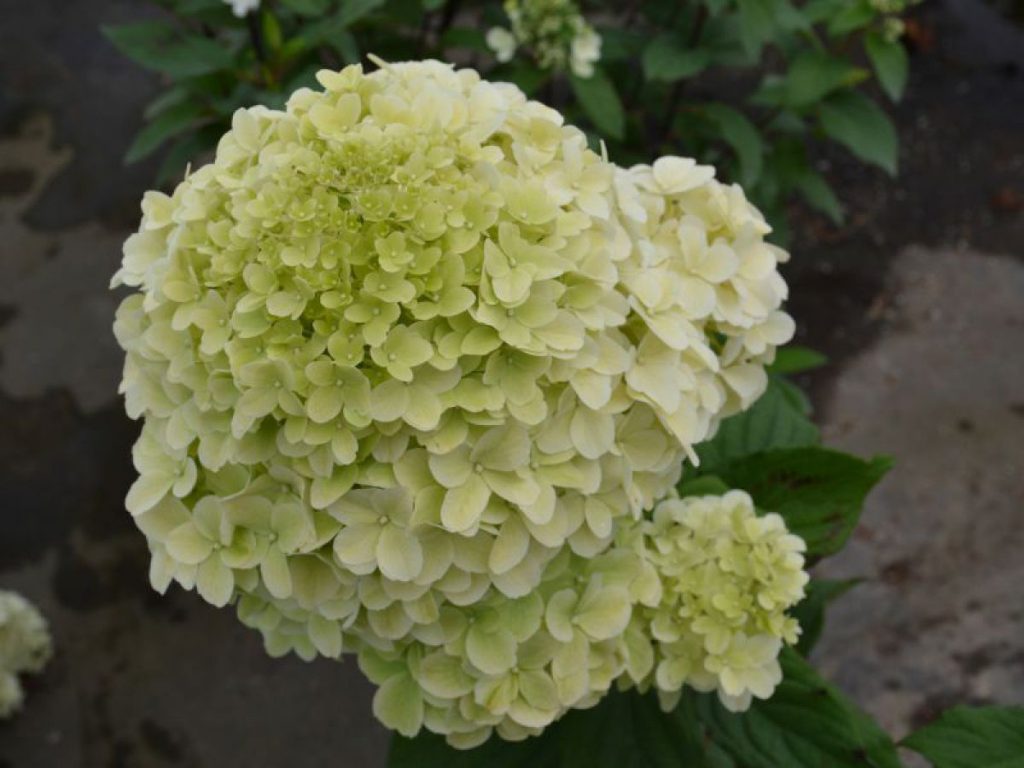
Hydrangea paniculata diamantino
Description of the plant
The Latin name is hydrangea paniculata diamantino.
Hydrangea grows as a lush perennial shrub with a slightly elongated crown shape. The maximum height is 1.5 m.
Stems are tough, erect, do not need a garter. Already in the second year of cultivation, green shoots are lignified. Leaves develop in pairs along the entire length of the branches.
The leaf plate is rough, ovoid, emerald on top, and grayish-green below.
The inflorescences are large, panicle-shaped, dense, with a circumference of 20-25 cm. The color changes depending on the season: at the beginning of blooming, they are yellowish-green with a golden tint, at the end of flowering they acquire a soft pink tint.
In place of dried flowers, seed pods 3-4 mm in size are formed. With good care, this plant begins to bloom in the third year of development.
Landing features
The successful cultivation of this variety depends on adherence to the rules and timing of planting, as well as further care.
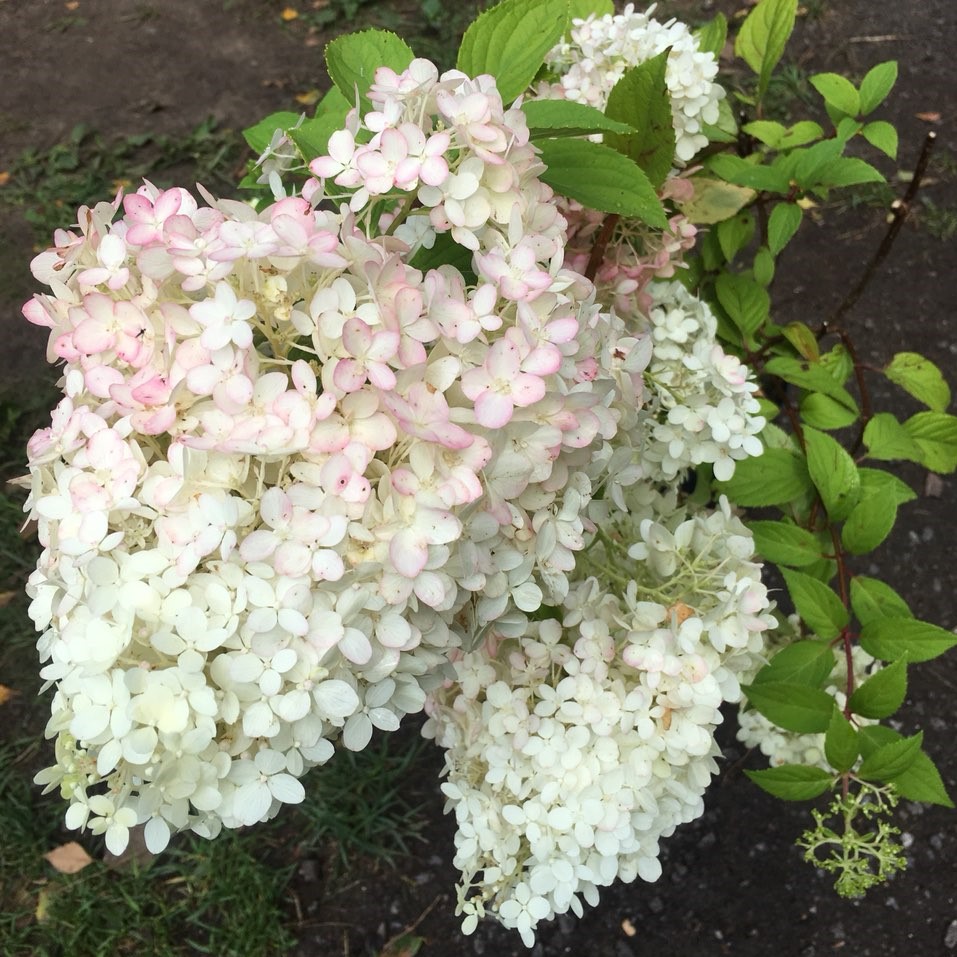
Hydrangea diamantino
Timing
The optimal time for planting this shrub is mid-spring or early autumn. In cold regions, spring planting will be preferable, so that during the season the seedlings have time to take root and prepare for the upcoming wintering.
Site selection and preparation
This ornamental crop has a good degree of winter hardiness and frost resistance - it can easily withstand temperatures as low as -30 ° C. Doesn't like drafts.
It prefers to grow in a sunny place, but foliage and flowers quickly fade from direct rays. Therefore, the site should be chosen with light shading at lunchtime.
Grows well in slightly moist, drained and nutrient-rich soil. The best composition will be a mixture of peat, humus and leafy earth in a ratio of 1: 1: 2.
If the soil is with a high degree of acidity, the inflorescences are bluish, on alkaline earth - raspberry.
It is not worth planting under tall trees and near other shrubs, since they will take the necessary moisture and useful components from the hydrangea, which will negatively affect growth and decorativeness.
Selection and preparation of planting material
You can buy Diamantino hydrangea seedlings in one of the specialized nurseries, where you will most likely be provided with a real variety. Give preference to 2 or 3-year-old specimens, which already have a well-developed root system and crown.
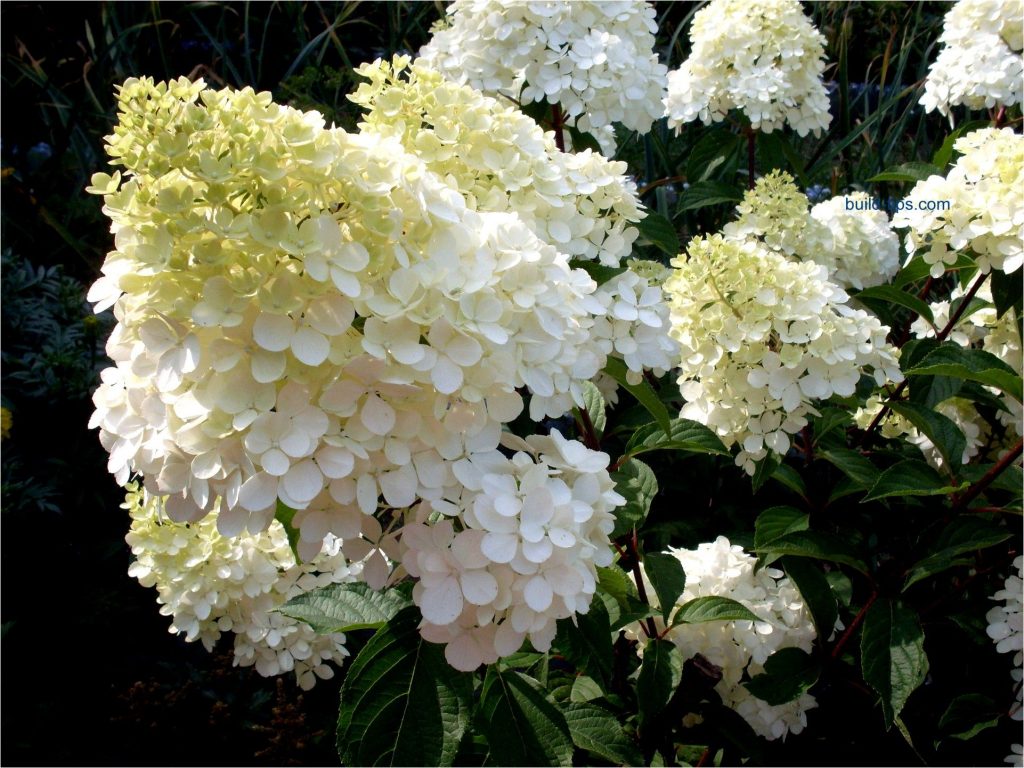
Diamantino hydrangea
Carefully inspect the stems, leaves, buds - they should be juicy, of a uniform color, without mechanical injuries and signs of infection with infections, pests. Shake off the crown - if the leaves do not crumble, then the hydrangea is fresh and you can buy it.
Seedlings in an earthen coma or planted in containers take root better after transplanting to the site than bushes with open roots. This is also worth considering when choosing.
Before planting, the root system is slightly pruned - such a manipulation causes the rapid growth of new shoots.
If the roots are dry (in plants without soil), they are immersed in warm water for two hours with the addition of Kornevin or Heteroauxin.
Landing technique
The plot is prepared two weeks before the planting of seedlings - plant residues, garden debris are removed, dug up, leveled.
Pits are pulled out slightly larger than the size of the root system. Approximate parameters - 30x40x30 cm. A couple of handfuls of pebbles or brick chips are poured into the bottom. Then it is half filled with a mixture of mineral, organic fertilizers intended for growing decorative flowering perennials. A little peat, sand and leafy earth are added to this composition, mixed.
They immerse the seedling in the hole, straighten the roots, sprinkle it with soil to the top. It is important that the root collar remains 4-5 cm above the surface of the earth, otherwise at the very first watering it will begin to rot and the plant will die.
The bushes are watered with warm and settled water, mulched with peat to prevent rapid evaporation of moisture.
Care
Young hydrangea diamantino requires competent and timely care, on which its growth, decorativeness and immunity will depend in the future.
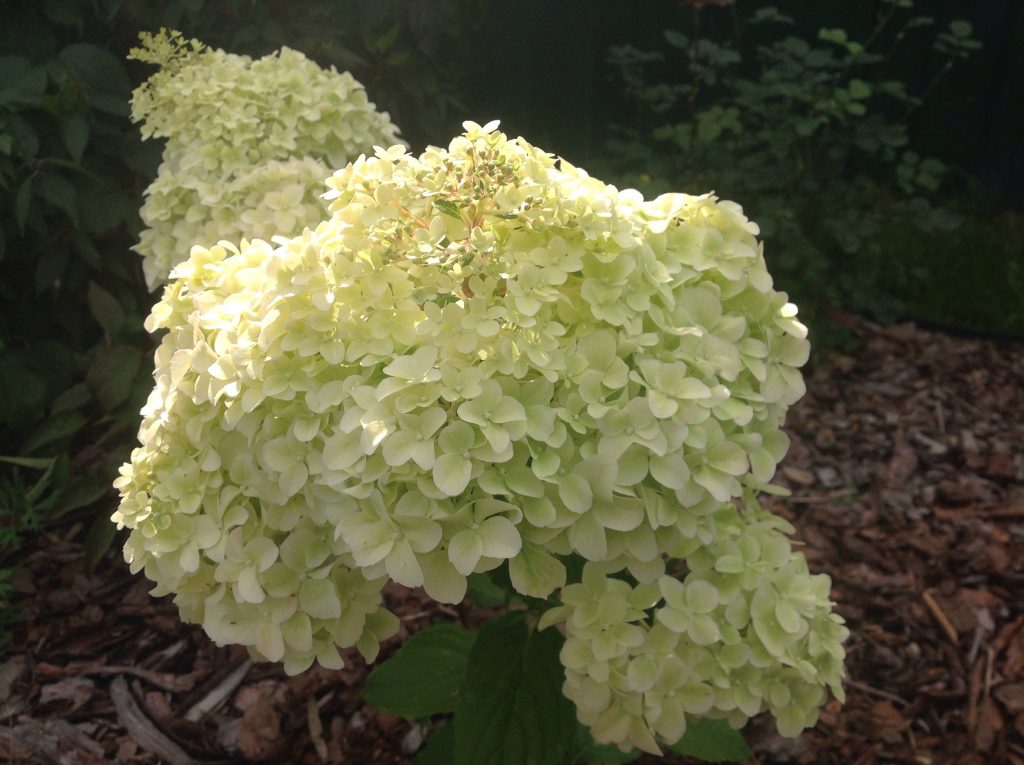
Hydrangea diamantino description and photo
Watering
Needs frequent but moderate hydration. In the warm season, the frequency is once a week. 20 liters of water are poured under one bush. In the fall, moisturize less often - once every 15-20 days.
After each watering, surface loosening of the soil is carried out so that it remains light, moisture and oxygen pass through well.
Additionally, mulch from humus and peat is introduced into the near-trunk zone. These components will provide additional nutrition and protect the soil from drying out.
Top dressing
To achieve high-quality flowering and resistance against diseases, diamantino hydrangea must be fed regularly. Fertilizers are applied throughout the growing season at least 4 times - at the beginning of spring, before the formation of buds, after the flowers have dried out and in late autumn.
Slurry is used for food. After application, watered abundantly to prevent burning of the roots and to speed up the process of absorption of nutrients.
Pruning
This procedure is carried out every spring - before the beginning of the swelling of the kidneys. With a sharp and sterile pruner, cut off all the branches that are dry, rotted, broken off or frozen over the winter.
To avoid infection, the cut areas are irrigated with a solution of copper sulfate.
Many are engaged in the formation of the crown - they cut off the stems that are too long, growing inward or at the wrong angle. Thus, the shrub is given a compact, spherical shape.
Preparing for winter
Despite a good degree of frost resistance, young seedlings up to three years old need insulation. If they are not covered, they will quickly freeze and die.
2 weeks before the first frost, young branches are shortened to 5 buds. The near-trunk zone is sprinkled with a thick layer of peat.
The shoots are tied with twine or rope, bent to the ground, fixed with staples, then covered with any breathable material - agrofibre, burlap. Spruce branches can be laid on top.
They remove the shelter in the spring, when the snow thaws and the heat of the street stabilizes.
Requirements before and after flowering
Before flowering, you need to reduce the frequency of watering to help extend this process. To form a large number of inflorescences, a week before the start of budding, the bush is fertilized with potassium preparations.
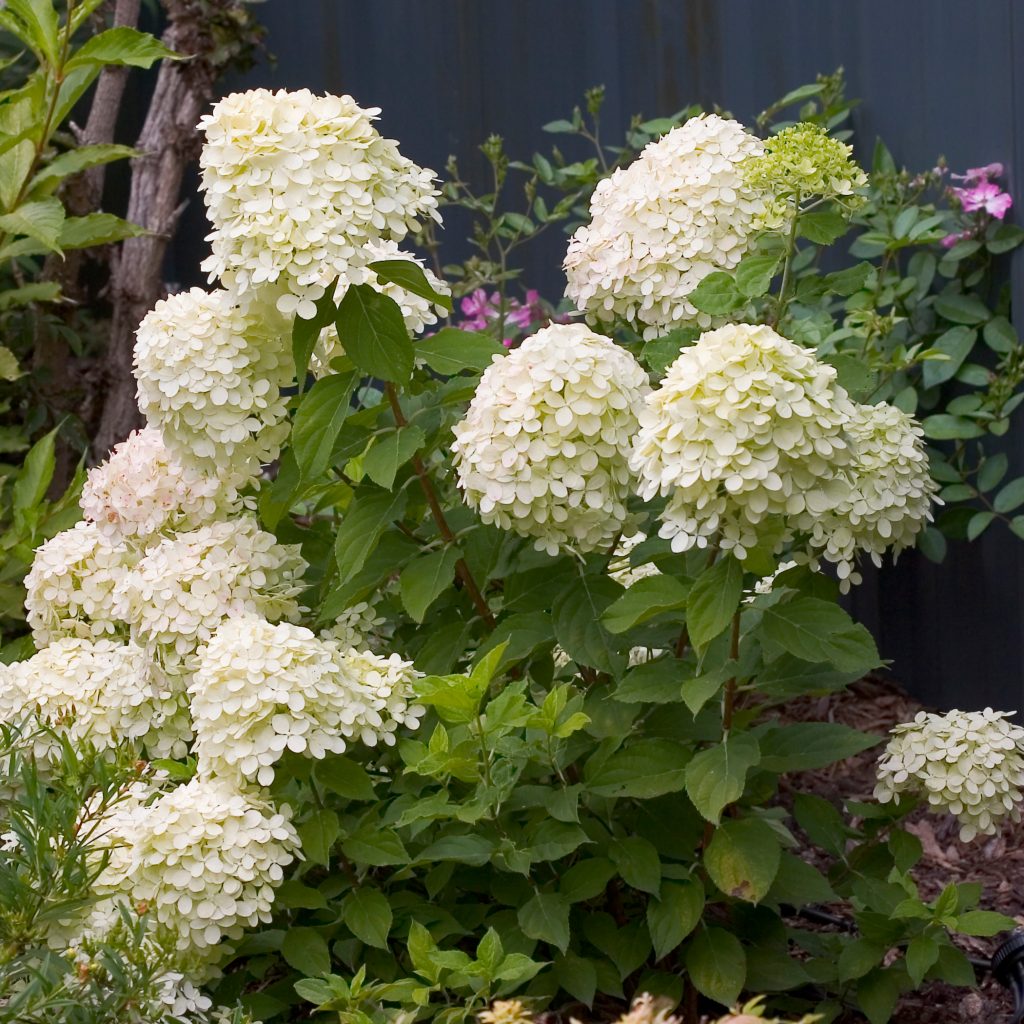
Hydrangea diamantino photo and description
At the peak of decorativeness, fertilizers are not applied, since this will reduce the quality and duration of the process.
After flowering, the hydrangea continues to be charged with moisture as needed, loosened and mulched.
Dried inflorescences are not cut off, since seeds are formed on them. In the future, they can be used for reproduction.
Reproduction
There are several options for breeding new seedlings, subject to planting and growing technology, the result will be justified.
Seeds
This is the most difficult and time consuming method. The collected seeds are washed in warm water, then sown in a flat seedling container filled with a moist mixture of peat and sand. For quick germination, the seeds are covered with transparent glass, kept at a temperature of 20-23°C, irrigate regularly from a spray bottle.
After the appearance of greenery, the shelter is removed, grown until the development of two leaves, dive in separate pots. As soon as they become overgrown with foliage, they are planted in open ground. They take care of the same as for purchased seedlings.
Cuttings
Reproduction using green cuttings is carried out in the summer. Segments 15-20 cm long are cut from the top of strong shoots. At the bottom, all the leaves are cut off, dipped in Kornevin's solution. They are planted in a sand and peat mixture to a depth of 3 cm at an angle.
In order for the seedlings to take root faster, they are placed in a warm place where there is diffused light, they are regularly moistened.
New leaves on the shoots are a sure sign that the cuttings have taken root. After a month of growing, they are planted in open ground.
Stem layering
On an adult bush from 5 years old, choose a flexible stem that is close to the ground. They tear off all the foliage on it. Nearby, a trench is dug 4-5 cm deep, sprinkled with a mixture of peat and sand. The branch is laid horizontally, fixed with brackets, sprinkled with the remaining soil mixture, watered.
A week before the first autumn frosts, they are covered with spruce branches, fallen leaves or burlap in order to prevent the branches from freezing for the winter.
In the spring, when the snow thaws, the layers are dug up, cut off from the mother bush. Divided into parts so that each has several roots, planted in open ground.
By dividing the bush
Used for old shrubs that need rejuvenation. The plant is abundantly watered, dug in, removed, washed off the remnants of the soil. Divide the rhizome into parts so that each has one stem with buds, leaves and roots.
Places of cuts are sprinkled with charcoal, dried, planted in the garden.
Diseases and pests
This perennial can become infected with various sores and parasites, especially if the rules of care and maintenance are violated:

Diamantino panicle hydrangea
- Powdery mildew, white and gray rot. Fungal infections that damage leaves, stems, buds. Before treatment, it is necessary to remove all diseased areas. Treat the crown with Pureflower or Fundazol.
- Of the pests, spider mites and aphids are annoying. Insecticides will help get rid of insects - Thiofos, Akarin, Vermitic.
- Often snails attack the hydrangea. They are collected by hand. In order to avoid re-invasion, special traps with a sticky substance are placed around the perimeter of the site.
For prevention, you should follow the planting scheme, buy healthy seedlings, take care of them correctly and on time - cut, water, loosen and feed them.
Application in garden design
Diamantina panicle hydrangea has become widespread in modern garden design:
- it is planted singly in flower beds, near gazebos, terraces;
- used in group plantings in combination with other ornamental shrubs - roses, junipers;
- the bush looks beautiful surrounded by undersized and ground cover flowers;
- Several bushes planted in a row create a lush, colorful hedge along the fence or walls of the house.
Testimonials
Most gardeners prefer this particular variety due to its unique qualities:
- a good degree of frost and winter hardiness allows cultivation even in the most severe zone of the country;
- when the composition of the soil changes in the direction of increasing acidity or alkalinity, inflorescences of several shades can be obtained;
- the ability to reproduce by different methods makes it possible to independently grow new specimens for landscaping the garden.

